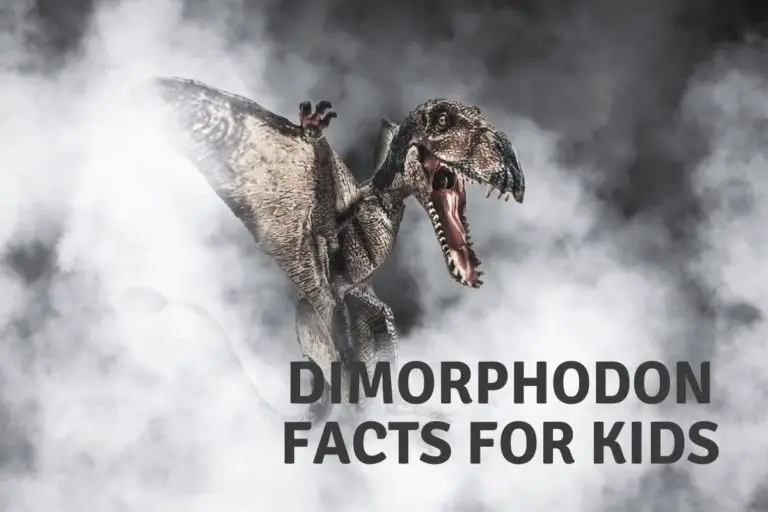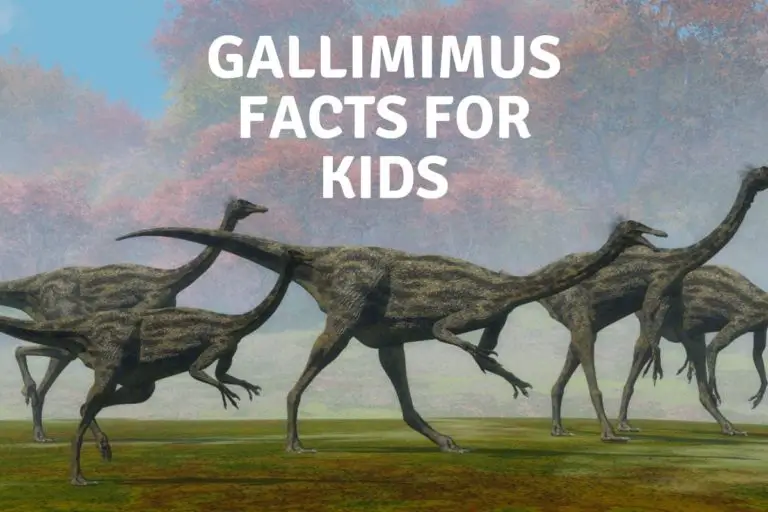What Was The Smallest Dinosaur? 8 Tiny Dinosaurs That You Need to Know About
Dinosaurs are believed to be the largest creatures in history ever to roam the earth. We know how big they were from their fossils displayed in museums or even in movies like Jurassic Park.
That’s why it may be surprising to learn that not all dinosaur species were big; many of them were similar in size to some small modern-day animals and some the same size as even the smallest of today’s animals.
So, what is the smallest dinosaur?
The smallest dinosaur discovered is the Oculudentavis, also known as the eye-tooth-bird. It’s about half an inch and weighs less than an ounce, making it similar in size to a hummingbird. This dinosaur lived 100 million years ago but was discovered quite recently, in 2020.
Keep reading to learn more about the Oculudentavis and other small dinosaurs in history.
What Is the Smallest Dinosaur?
The smallest dinosaur discovered is the Oculudentavis; it was about half an inch and weighed less than an ounce, which is similar in size to a modern-day bee hummingbird. Well it was for a short time.
The name chosen for this dinosaur translates to “eye-tooth-bird” because researchers found that it has lots of teeth and distinctively large eyes. It was also nicknamed “the cretaceous terror of insects” because researchers believe that it was a predator despite its small size.
This species lived over 99 million years ago, and its fossils were discovered inside a drop of amber. It sparked much debate among researchers as they couldn’t determine whether it was lizard-like or bird-like from its fossils. (since been agreed it was a lizard rather than a dinosaur – albeit a very strange looking lizard)
It’s very common, however, that many of the smallest dinosaurs are bird-like in appearance.
List of Other Smallest Dinosaurs
There were many other small but fascinating dinosaurs other than the Oculudentavis. So, let’s take a quick look at some facts about them. We have included this both in the table below and in a infographic near the end of this section.
Table 1: Examples of What were the smallest dinosaurs.
| Dinosaur | Type of Dinosaur | Height | Length | Weight | When Lived |
| *Oculudentavis (probable lizard) | Possible Avialan (bird wing like) | 0.5 inches 1.5 cm | 0.68 inches 1.73 cm | 0.8 ounces 25 grams | 99 million years ago |
| Parvicursor Remotus | Maniraptoran | 0.5 feet 15 cm | 1.3 feet 39 cm | 5.7 Ounces 162 grams | 72 million years ago. |
| Epidexipteryx hui | Paravian | 0.5 feet 15 cm | 0.9 feet 25 cm (1.3 feet – 44 cm with tail | 0.35 lbs 163 grams | 164 million years ago |
| Anchiornis Huxleyi | Theropod | 0.6 feet 17 cm | 1.3 feet 40 cm | 0.55 lbs 0.25 kg | 163 -144 million years ago |
| Microraptor | Dromaeosaurid | 1.3 feet 60 cm | 2.53 feet 0.77 metres | 2.2 lbs 1.0 kg | 120 million years ago |
| Aquilops | Ceratopsian | 0. 5 feet 15 cm | 2 feet 60 cm | 3.3 lbs 1.5 kg | 109 million years ago |
| Compsognathus | Theropod | 0.7 feet 20 cm | 2.5 feet 80 cm | 0.71 lbs 0.32 kg | 150 million years ago |
| Dilong Paradoxus | Theropod | 1.6 feet 45 cm | 5.2 feet 1.6 metres | 13 lbs 6.0 kg | 126 million years ago |
| Gasparinisaura | Ornithopod | 2 feet 60 cm | 5.6 feet 1.7 metres | 29 lbs 13 kg | 83 million years ago |
| Mahakala | Dromaeosaurid | 0.7 feet 20 cm | 1.5 – 2 feet 50-70 cm | 1-1.5 lbs 0.4 – 0.7 kg | 75 million years ago |
* while Oculudenttavis has been more recently reclassified, or more accurately classified, as an early and very strange lizard rather than a dinosaur we are keeping it on our list of smallest dinosaurs.
It is a demonstration that in a time of giants, which are both more famous and more popular, there were an equal or greater number of smaller animals and dinosaurs that walked the earth at this time as well.
You can check out the smallest, if not cutest, carnivorous dinosaurs of all time here.
1. Parvicursor Remotus
- The Parvicursor Remotus is about 12 to 15 inches and weighs only 5.71 ounces.
- Its name means ‘small runner’ because it has long, thin leg and although it is only known from partial remains it is certainly one of the smallest dinosaurs on this list.
- The Parvicursor fossil discovered consisted only of the pelvis and hind legs.
2. Epidexipteryx hui
- Epidexipteryx hui is about 9 to 17.5 inches and weighs from 5.8 to 13.8 ounces, making it one of the smallest dinosaurs.
- It had a bird-like appearance with a long tail that contained four feathers.
- Researchers believe that it couldn’t fly and that its tail allowed it to balance better to climb trees.
3. Anchiornis Huxleyi
- The Anchoring Huxleyi is about 13 to 16 inches and weighs from 3.9 to 24.7 ounces givng it a definite place on the list of smallest dinosaurs.
- It also had a bird-like appearance with a long tail and long feathers on its limbs.
- Its colors are believed to have been a mix of black and grey, with white strips on the wings and a red crown. Researchers could determine those colors by studying the remaining pigment cells in the fossils.
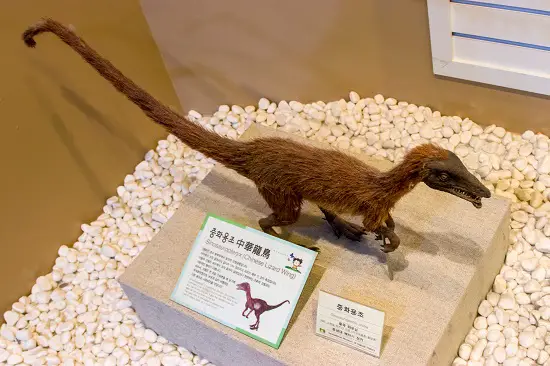
4. Microraptor
- The Microraptor is estimated to be 3.93 feet and weighs about 2 pounds.
- It also had a bird-like appearance and was one of the first dinosaurs with feathers discovered. It is also one of the the smallest dinosaurs.
- It’s nicknamed “the four-winged dinosaur” because it had feathers on its arms and legs
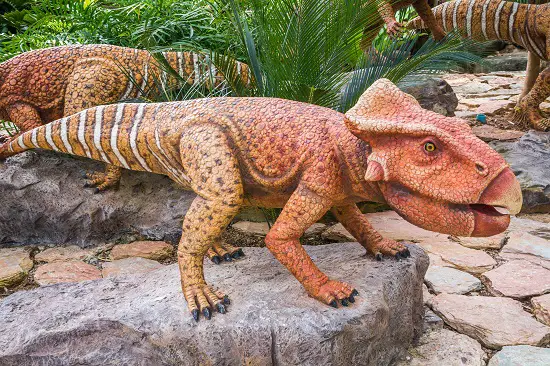
5. Aquilops
- The Aquilops is 2 feet and weighs about 3 pounds.
- It’s one of the smallest of the horned and frilled dinosaurs, mostly discovered in Asia. However, the Aquilops were discovered in North America.
- it was similar to microceratus which is another of the smallest dinosaurs.
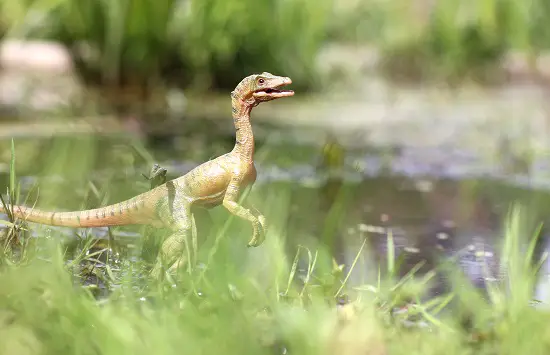
- The Compsognathus is estimated to be 2 to 3 feet and weighs about 6 to 7 pounds, which is similar to the size of a chicken. For a lot of years it was thought to be the smallest dinosaur ever, and still makes anyones top ten smallest dinosaur lists.
- It is one of the smallest of theropods, which were carnivorous dinosaurs that walked on their two hind legs. Some of the largest theropods include Tyrannosaurs (T Rex) and Spinosaurus.
7. Dilong Paradoxus
- The Dilong is estimated to be about 5.24 feet and weighs about 25 pounds.
- It was discovered in 2004 and is also considered one of the smallest theropods and well as smallest dinosaurs, it was a ancestor of T Rex and other larger theropods.
8. Gasparinisaura
- The Gasparinisaura is estimated to be about 5.6 feet and weighs about 25 pounds, making it the largest dinosaur on this list.
- It is one of the smallest ornithopods as well as smallest dinosaurs, which were two-legged herbivorous dinosaurs ancestral to hadrosaurs.
Smallest Dinosaurs Infographic
We have an infographic you can use here but if you put it on your site please credit and link back to us. you can click the image to make it full size.
How Big Did Dinosaurs Get?
There are many fascinating facts about dinosaurs, from their different species to their diet. However, the thing that continues to amaze everyone, researchers and the general public alike, is their large size.
According to a research analysis conducted in 1995, the average dinosaur weighs about 2000 pounds. The research was refined later in 2015 and showed that the average dinosaur is estimated to weigh about 1400 pounds, which is similar to the size of a modern-day American Bison.
Some dinosaur species even exceeded that size. For instance, the largest dinosaur species discovered are the sauropods, which had long necks and tails.
The largest of the sauropods is believed to be the Argentinosaurus. It’s estimated to have reached about 10 feet and weighs up to 100 tons.
However, it’s difficult to confirm for sure which is the largest sauropod as only a few of their remains were discovered. Other possible candidates for the largest sauropod include Turiasaurus, Puertosaurus, Ruyangosaurus, Pellegrinasaurus, Bruhathkayosaurus, Patagotitan, and more.
Why Did Dinosaurs Get So Big?
Since it is rare for modern-day animals to grow as big as most dinosaurs did, researchers developed several hypotheses to understand the reason behind this.
So, here’s a simple breakdown of a few of these hypotheses:
They Breathed Better Oxygen
The first hypothesis states that the environmental factors at the time, such as higher oxygen content, explain the dinosaurs’ large size. So, to put it simply, dinosaurs grew so big because they breathed better oxygen.
This hypothesis is supported by a 2019 study published by researchers at the Texas Austin University and the Rensselaer Polytechnic Institute. They discovered that the air was rich in oxygen back then by analyzing the gas content inside rocks from over 215 million years ago.
They Were Efficient Feeders
The second hypothesis states that dinosaurs grew so big because of how they fed and what they fed on.
For instance, dinosaurs with long necks, like sauropods, would’ve been able to reach the kinds of food that other dinosaurs could not access and generally feed more.
So, theoretically speaking, sauropods grew bigger than other dinosaurs because they were more efficient feeders.
They Had Light Bones and A Complex Respiratory System
This hypothesis states that the dinosaurs’ biology is one of the reasons they grew so big, particularly their bones and respiratory system.
They had very light bones, which allowed them to grow to massive sizes without collapsing in on themselves. Their respiratory systems had efficient lungs with a complex system of air sacs, so their respiration and heat exchange allowed for better support for their large size.
Cope’s Rule
The Cope’s Rule hypothesis was formulated and named after Edward Cope, who was a famous paleontologist. It stated that animals who come from evolving lineages have a tendency to grow larger over time.
The hypothesis was supported by a 2012 study published by researchers from the National Museum of Natural History’s Department of Paleobiology. They studied femur bones from dinosaurs to detect their size. Then they applied advanced statistical methods to the data to look for directional patterns in size over time and determine if there were any limits to the size.
We also have a selection of articles on the largest of different types of dinosaurs here on the site and you can check these out in the list below.
- What was the largest Dinosaur?
- What was the largest meat eating dinosaur?
- What were the largest flying dinosaurs
- what was the largest armored dinosaur
- what was the largest Horned dinosaurs?
We have a series of articles on How Big Dinosaurs were and you can follow the links below to check out the size of other popular dinosaurs.
And if you wanted to know some of the smallest dinosaurs ever you can check out the article on the site as well. As although dinosaurs are often thought to be huge monstrous animals there were plenty of small ones as well and we take a look at them on the link above.
How Can We Tell What Size Dinosaurs Were?
We cannot tell with absolute certainty what size dinosaurs were because, after all, everything we know about them is based on the fossils discovered.
Researchers and paleontologists study the structure of these fossils and then compare them to the body structures of modern-day animals to estimate the dinosaurs’ size, weight, and overall shape.
Certain markings on the fossils can also indicate where the tendons and muscles were attached to the dinosaur’s body to flesh it out and give us a clearer idea of how dinosaurs looked when they were alive.
However, it’s still impossible to tell what dinosaurs looked like from just their fossils. For example, a whale’s skeleton looks completely different from a live whale, and it’s difficult to determine what whales look like by only studying their skeletons.
With that in mind, it’s also difficult to identify which prehistoric animals were the smallest or the largest based on just the remains of their fossils. For instance, the skeletal remains could either belong to a small dinosaur or it could belong to a young dinosaur of a larger size.
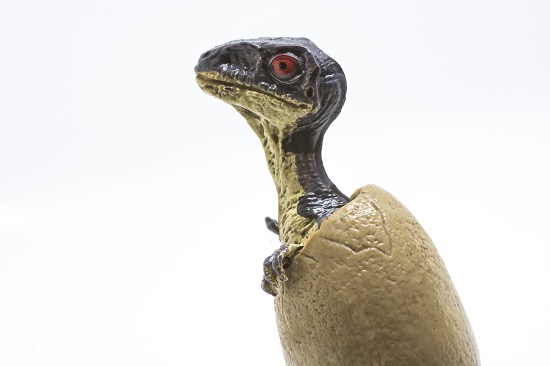
Related Questions
How Big Were Baby Dinosaurs?
The size of one of the baby dinosaur eggs discovered was only a few inches. The eggs were unlaid and discovered in the abdomen of a fossilized Sinosauropteryx. Another baby dinosaur embryo discovered was about 6 inches long; it was curled in an egg that was about 2.5 inches long.
What Is the Oldest Dinosaur?
The oldest known dinosaur is the Eoraptor, which is estimated to be about 228 million years old. It’s followed by prosauropods which are about 230 million years old. Other old dinosaur species include Pisanosaurus, Herrerasaurus, Staurikosaurus, and Lesothosaurus.
What Other Prehistoric Animals Were as Big as Dinosaurs?
Some of the prehistoric animals that were as big as dinosaurs include Steppe mammoths, Ngandong tigers, and Steller’s sea cows; however, none of them reached the size of the biggest dinosaurs. The biggest prehistoric mammal known is the Indricotherium, which is an ancestor of the modern-day rhino.
Resources
- A Tiny Dinosaur and a Big Discovery
- The 19 Smallest Dinosaurs and Prehistoric Animals
- How Did Dinosaurs Get So Big?
- Smallest Dinosaur actually a lizard
Hi, I am Roy Ford a General Studies and English Teacher who has taught all over the world. What started as a fossil collection became a great way to teach, motivate and inspire students of all ages and all over the world about dinosaurs and from that and children’s love of dinosaurs came the site dinosaur facts for kids, a resource for all ages.


